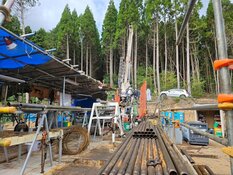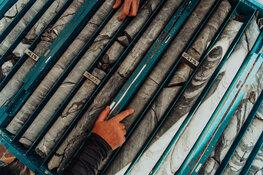Ron Struthers: In the first place, the U.S. economy has never been in recovery. It was more or less just a statistical recovery. GDP increased because of the way it is calculated, but the real economy and people on the street experienced no growth. Better employment numbers were the result of temporary government hires and those created by the Bureau of Labor Statistics' (BLS) small business birth-death rate model. "Cash for Clunkers" helped the auto industry temporarily, but now auto sales have plummeted. Stimulus for housing only slowed or paused the decline; now that those programs have expired, housing has plunged further. I could go on! Those bearish fundamentals and others are coming back to the point that the market and its followers are beginning to realize the economy is still declining. A lot of people are calling for a double-dip recession, but I don't even think we came out of the recession. This is just a deeper plunge, and will feel more like going into depression.
There are also the debt issues. So far this is mostly focused on Europe, but the U.S. is a bigger problem. Many of the U.S. states are bigger than Greece, and 40 or more of them are in the same bad shape. I expect that to come to the forefront before long because those states are going to have to have federal bailout assistance.
TGR: Are you saying the U.S. government is going to have to print more money?
RS: They'll probably try that as a solution. Whether the market will put up with it, I don't know. We'll see. At that point, you'd have to watch the bond market and the U.S. dollar to see how they're reacting. Like Europe, they might have to go more with severe austerity programs that will push the economy down further.
TGR: You watch the market very closely. Your research seems to indicate that you look to the S&P 500 for monitoring the market.
RS: I think that's the best index to follow as a gauge for the market. It's fairly broad based compared to the Dow.
TGR: What are you seeing in the S&P 500 that made you think it would be just a short-term rally?
RS: We had that topping formation in May and June. I was actually expecting to see the market rally up further, maybe come close to retesting that top as more of a confirmation that we had a top. Instead it's done much worse. It's actually broken down far enough to make a lower low than February's. It's really turned into bear market territory in the short term.
TGR: As a hedge against a significant market correction, you recommend investors hold about 40% of their portfolios in cash. Does that include gold?
RS: No, I've been suggesting about 15% in gold. If you go 20%, that's not bad either. In my portfolio, we're really sitting on 15%–20% gold and 35%– 40% cash.
TGR: What's in the cash component?
RS: Right now it's strictly cash, but I've been suggesting that cash be used to start shorting the market through ETFs. The one I like is Horizons BetaPro S&P 500 Inverse ETF (HIU). It's not leveraged at all, so it's much better for a longer-term hold. You really have to be a trader to use leveraged ETFs effectively.
TGR: Is the premise of that ETF an inverse relationship to the S&P 500?
RS: Yes, it's just 1-to-1 in terms of an inverse relationship. It's not leveraged at 2-to-1 or 3-to-1 like some of the ultra-short ones. I suggest putting about a third of the cash position into that.
TGR: How long should you stay vested?
RS: The time horizon we're looking at for the market to move down substantially is before the end of the year. If it rallies more and we have a better entry point, we'll add to the HIU. Or if it breaks down further and confirms momentum to the downside, we'd also add more to the position.
TGR: You quote a stat in another Struthers Resource Stock Report that says 90% of short-term trades lose money. You also stick to the old adage that says, "The trend is your friend." With those two points in mind, what are some long-term trends you see in the gold sector?
RS: Obviously gold itself; it's been in a bull market for 8–10 years, depending on how you want to measure it. We basically don't sell or trade our gold. We just buy and hold it. We've been increasing the percentage held; we were at 0%, then 5%, 10%, 15%. We are just going to hold it until I see some good signs that the market is peaking out and reversing. Then, of course, we'll be selling.
TGR: In that 15%, what is your equities-to-bullion mix?
RS: That 15% is just bullion. I suggest you have actual physical gold like coins and bars or funds. I like the Central Fund of Canada Ltd. (NYSE.A:CEF; TSX:CEF.A), which is 50% gold and silver, or Bullion Management Group, Inc. (TSX:BMG100), which is divided evenly between platinum, gold and silver. Basically, these funds have the precious metals allocated and audited—you know the gold is there. Sprott has one called Sprott Physical Gold Trust (NYSE.A:PHYS; TSX:PHY.U), which is 100% gold. I really watch the premiums. The one with the lowest premium is what I'd be buying.
TGR: So you believe in holding physical gold, holding coins.
RS: Yes, you can look at it as insurance or just a core savings. The bullion holds its value. If you hold cash money in the bank, you lose purchasing power all the time. With low interest rates, your return on investment is not good; you're not getting anything on it. And there aren't many good alternatives. Either buy gold or hold cash that pays you nothing. You could put your money into bonds, but they've been in a 20- to 30-year bull market so there's nothing left to be gained there. The risk is high that bondholders are going to lose money in the years ahead as interest rates rise, pushed by high debt levels. Or you could gamble in the stock market. I think gold is a pretty important asset to hold right now.
TGR: But for people who don't want to buy coins or hold bullion, gold equities are another way to gain exposure to gold. Some gold plays are always media darlings.
RS: One that's had some recent articles in The Northern Miner, Resource World and Casey's Gold Research is Otis Gold Corp. (TSX:OOO; OTCBB:OGLDF). I like them, too, and have been following them since inception. I know some of the principals involved and their geologists.
That's a key thing in any of these companies—the people. It's the people who build a company, so it's important to have confidence in who's running a company. That's the number-one thing I look for in junior mining companies. The other consideration when I'm looking at junior gold stocks is their gold in the ground. I think Otis is probably up to about half a million ounces. With this drill program they're doing now, they're probably going to be closing in on the million-ounce mark.
TGR: What are the Otis people telling you about their Kilgore deposit in Idaho?
RS: There's not a lot of risk there anymore. A fair amount of drilling has been done and data collected on it. It's now more of a matter of drilling and proving out the ounces; stepping out on trend and checking some of the other areas nearby. That gives it the upside. The key upside will be when they drill the Dog Bone Ridge target, which lies on the other side of the Kilgore deposit. . .the potential is 3 million ounces there if they hit. Drilling is slated there for September.
TGR: Otis is trading close to its 52-week low. Given the positive drill results you just mentioned, to what extent do you consider $0.39 a good entry point?
RS: The positive drill results were in the last drill program and they just started a new 6,000-meter, 30-core hole drill program in June. One could buy the stock now ahead of expected drill results because we know, from past drilling, that the gold is there. We should see some good results that could move the stock again. The stock is down around $0.44 with the recent correction in the junior gold stocks, and it is not pricing in any speculation on the current drill program. With Otis, the time and conditions are right—exactly how I like to buy junior golds on an exploration play. Downside is small but upside can be very high, depending on what the drills turn up.
TGR: This past spring you said your plan was to add some more gold and silver stocks to your list, starting with Everton Resources (TSX.V:EVR; Fkft:ERV). At the time, the stock was trading around $0.30; now it's about $0.20. Tell us about that one.
RS: We got into Everton around $0.26; at $0.20, it is even a better deal. They don't have any proven gold yet; but I like Everton because they've had lots of good drill intersections on some of their properties, such as 6 meters of 192.5-gram silver at their La Lechoza prospect. Their main project is right next to Barrick Gold Corporation (NYSE:ABX; TSX:ABX) and Goldcorp Inc.'s (NYSE:GG; TSX:G) Pueblo Viejo Mine, which hosts around 29 million ounces gold, in the Dominican Republic.
Everton is right on trend. Some of their drill core on some wildcat exploration holes hit the exact same host rock as Pueblo Viejo. Their challenge is about a 30-meter cap over the host rock; there's not much outcrop to guide drilling. They've gone back and done all the geological work, the induced polarization (IP) surveys, geochemistry, soil and stream samples to come up with good drill targets. They should be drilling more on this pretty soon. I think more information will increase their odds of hitting mineralization.
TGR: Why wouldn't Barrick have staked all the land around that deposit?
RS: That is a good question. In fact, they did have quite a large area staked because their land position there is pretty huge. But you know, Barrick and a lot of the other majors aren't really the explorers anymore. They cut back on all their people and exploration budgets in the downturn in late 1990s, early 2000s, and it is very hard to get back or find good people in the industry now. So they focus their exploration around their current mining operations and try to keep growing reserves at their mines. It is cheaper for them to let the juniors explore and buy the deposits from them when found.
TGR: What other gold companies are you following, Ron?
RS: Another one I like is down in Mexico: Levon Resources Ltd. (TSX.V:LVN; Fkft:L09; OTC:LVNVF). They've made what I would say is a potentially massive discovery. It's a silver/gold/lead/zinc target very similar to the Peñasquito mine that Goldcorp's putting into production now. Peñasquito probably will be one of Goldcorp's most profitable mines, and Levon's discovery hole is actually higher grade than the average Peñasquito grades were in the beginning. The discovery hole is 152 meters of 80 grams silver, 0.6 grams gold, with 1.4% zinc and 1.2% lead. That's some very good, rich rock over long intervals—and that's important. The intervals go for hundreds of meters.
TGR: Would it be the same mineralized system as Peñasquito?
RS: Yes, basically, Peñasquito's not too far away. I think it's maybe 20 or 30 kilometers. It's kind of on the same belt and trend. Levon actually has quite a large property, with about four more targets like this. There's potential for a couple of large deposits there. The mineralization also starts at surface, so strip ratios will be low, adding to the profitability.
TGR: Mexico seems to be a hot spot. In addition to Levon and Peñasquito, are there any other silver or gold plays in Mexico that you like?
RS: Minefinders Corporation (TSX:MFL; NYSE:MFN) recently went into production. Another one just starting production is Avino Silver & Gold Mines Ltd. (TSX.V:ASM,OTCBB:ASGMF). They have owned the Avino Mine for quite some time. I think they originally owned 50%, but now they have 100%. It was producing up until 2001 or 2002 and was closed because of low metal prices. They've completely refurbished and rebuilt that mill and are just now tweaking it and fine-tuning the recoveries. Prior to that, they discovered another new zone with fairly high-grade silver; it's running 5–6 ounces silver per ton with some copper. I'm expecting that stock to do well as production ramps up and cash flow and earnings kick in.
TGR: What are some other silver companies you're following?
RS: I follow First Majestic Silver Corp. (TSX:FR; OTCQX:FRMSF) in Mexico, as well. It has a good production growth profile and the cash flow and earnings are growing as well. In the second quarter ending June 30th, production hit a new record of 1,651,411 silver equivalent ounces, up 72% over the same quarter. In 2009, we also picked up Hecla Mining Company (NYSE:HL), which operates some in Mexico with all their production now coming from well-established, low-cost mines—Lucky Friday in Idaho and Green Creeks in Alaska. It was a bottom-fish play in 2008 when the market collapsed. We picked up a lot of bigger-name companies that I thought were on the cheap. We were able to buy Hecla at $1.25. When you can buy those major mining companies at those prices. . .that's why I jumped in.
TGR: Does Hecla have any mines coming onstream in the near future or is it simply a steady producer?
RS: Yes, that was the main reason we went in. It was just a good production story and management has a lot of experience dealing with difficult markets over the years and low metal prices. I think it was like all the companies that had a bit of debt back in 2008. When companies had debt, everybody started worrying.
TGR: Has Hecla taken care of that?
RS: I think Hecla's debt level is small or gone now. It never was a big problem; it was just the market's perception. Everyone was fearful of debt in 2008. Hecla took on some debt in 2008 to buy 100% of Greens Creek, which, in hindsight, was bad timing. Then the stock dropped and the equity-to-debt ratio looked terrible; but the problem was the equity value, not the debt level. It was trading way below book value.
TGR: Tell me a bit about what you like about silver as a commodity.
RS: Silver has two roles—as a commodity and for industrial demands. It's big in the electronics industry, which we know just keeps growing and growing. It's also used heavily in the automotive sector, which may not be growing here, but Asia is seeing strong growth; so there's an underlying demand there it terms of industrial uses.
Silver has become more of a currency, as well, along with gold; it's sometimes called "poor man's gold." Silver was in all the coins up until the late 1960s. It was accepted as real money until that point. I think demand will only increase as the gold price rises. New investors will come into the precious metals market and they might not want to pay $1,500 or $2,000 for an ounce of gold. They'll look at silver as a cheaper way to get into the market. I think that will be another market development down the road.
TGR: What's the multiple right now of silver to gold?
RS: In the neighborhood of 66-to-1 or 67-to-1.
TGR: That's a little on the high side compared with historical averages.
RS: Yes, historically, I think it'd be more like 55-to-60 or close to that range. It's offering a little bit of value when you measure it that way. I think silver has a bit more potential in terms of percentage growth than gold. It probably has to break through the $20 mark, just as gold had to with the $1,000 psychological barrier.
TGR: Then it might shoot up from there?
RS: Yes, that's what I'm looking for. While gold has broken well above its 1980 high, which was just over $800, silver is nowhere close to the $50 high it achieved back then.
TGR: This has been great. Thanks so much for your time today, Ron.
Ron Struthers, editor of Struthers' Resource Stock Report, retired at an early age from IBM, where he spent many years in customer service and as a systems, business and inventory analyst. He began the Struthers' Resource/Tech Stock Report almost 20 years ago and now has roughly 450 subscribers. Over the previous 10 years, Ron's top 82 stocks averaged a gain of 935%. Ron focuses on mining, oil and gas and one to three tech stocks a year. He hunts for stocks that are not yet discovered and gets in before the crowd. Most of these are companies on the verge of new mineral discoveries, moving to producer status or simply on an accelerating growth path. Coverage includes senior and junior companies with ample trading liquidity. Ron's a long-term investor, picking major trends and sticking with them.
Want to read more exclusive Gold Report interviews like this? Sign up for our free e-newsletter, and you'll learn when new articles have been published. To see a list of recent interviews with industry analysts and commentators, visit our Expert Insights page.
DISCLOSURE:
1) Brian Sylvester of The Gold Report conducted this interview. He personally and/or his family own the following companies mentioned in this interview: None.
2) The following companies mentioned in the interview are sponsors of The Gold Report: Otis, Goldcorp, Minefinders, First Majestic and Everton.
3) Ron Struthers: I personally and/or my family own shares of the following companies mentioned in this interview: Horizons BetaPro ETF, Central Fund, Otis Gold, Everton Resources, Avino Silver, Levon Resources and First Majestic. I personally and/or my family am paid by the following companies mentioned in this interview: None.










































